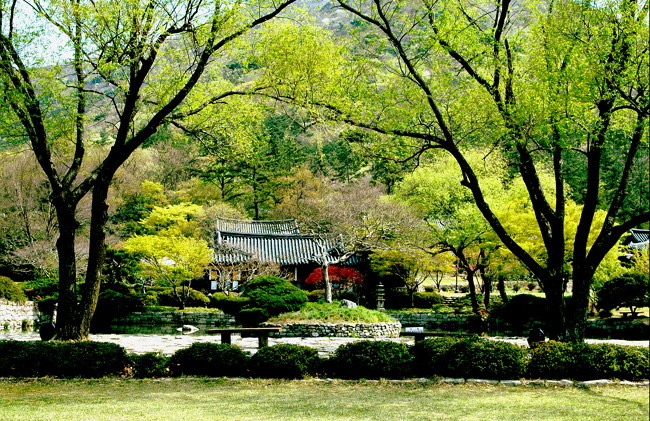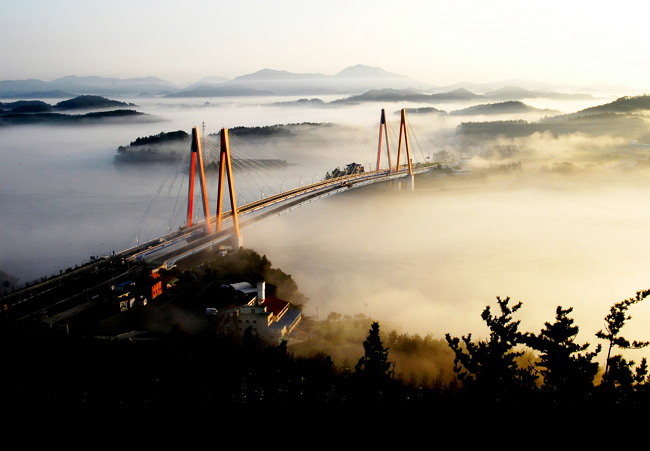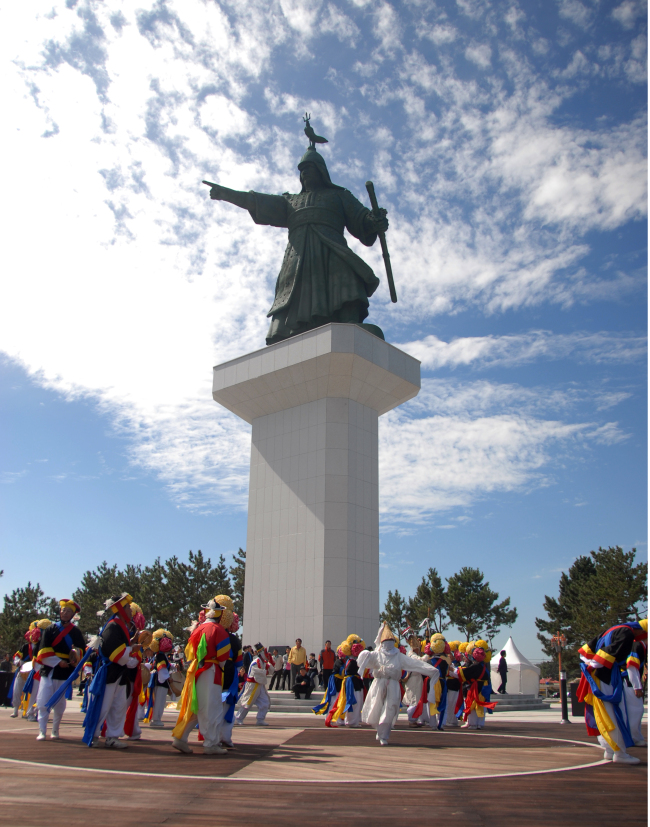JINDO, South Jeolla Province ― A grueling 5-hour drive from Seoul seems to be a small price to pay for the chance to become immersed in this island’s majestic scenery of mist-shrouded cliffs hovering above a picturesque coastline.
Jindo Island of South Jeolla Province is South Korea’s third-largest island. Despite being raised in the public consciousness for the recent Sewol ferry tragedy that left more than 300 dead or missing, its natural beauty remains vibrant, with the scenery consisting of rolling hills and the vast open sea.
Due to these qualities, the island has long been regarded as a perfect getaway for city dwellers.
To some, it may come across as a typical rural area packed with green rice paddies and old farm houses with blue roofs. But driving around, you soon realize that a different panoramic view greets you every 10 minutes.
Recently, several major developments have further increased Jindo‘s appeal to travelers.
“There’s a saying that no one can challenge Jindo in handwriting, traditional music and painting,” said Oh Gwi-seok, a Jindo County spokesperson. “The county government has designed a four-day program so that travelers can see, listen and feel for themselves what all this means.”
 |
A view of Local Monument No. 51 Ullimsanbang, an art studio of the painter Sochi and his descendants in Sachon-ri, Jindo County, South Jeolla Province. (Jindo County Office) |
To accommodate more visitors during the high season, three of Jindo’s most recently built fishing villages have increased their lodging options.
One such option is the floating lodge on Jeopdo Island which is connected to Jindo by a bridge. Jeopdo comes under Jindo County’s jurisdiction.
Jindo residents say the lodge is the perfect spot to unwind after a day of traveling. The rooms cost about 150,000 won ($147) per night, and visitors are offered a five-minute boat ride to the barge and fishing rods.
Each shelter resembles an igloo, and it is equipped with a shower facility, kitchen and blankets.
The restrooms are shared, but the stalls were clean and well-managed.
“We have a designated a captain to carry the passengers safely to the shelter, and there is also a manager on call 24/7,” said Han Hye-sung, chief director of the Jeopdo floating lodge. “I come here quite often to check on things, and the atmosphere is different every time I visit.”
A stay at the lodge proved that waking up to the sound of the sea is a peaceful and relaxing way to start the day, after which time slips by watching the water that eventually becomes the backdrop for a stunning sunset.
The island’s long and varied history can be witnessed from Jindo Bridge, which has become a symbol of the island.
 |
An aerial view of Jindo Bridge, which connects Jindo Island with Haenam. (Jindo County Office) |
 |
A monument of Admiral Yi Sun-sin located near the Myeongnyang Straits (Jindo County Office) |
The bridge stands over Uldolmok Strait where Korea’s legendary naval hero Adm. Yi Sun-sin won the Myeongnyang battle with 13 ships against more than 100 Japanese vessels.
The battleground has recently become even more popular due to the success of “Roaring Currents,” a historical action film that is now a box office hit. It broke Korean box office records, drawing more viewers than any other film in Korea.
Even a breed of dog is linked to the island’s past.
Centuries ago, Jindo dogs began inhabiting the island with the area’s ancestors. Opinions vary on the origin of these loyal canines, but the most persuasive theory is that Mongolian invaders brought them when they invaded Korea in 1270.
In 1962, Jindo dogs were designated as a national treasure. Since then, to protect the country’s most celebrated breed, dogs who leave or live outside the island have not been recognized as Jindo dogs. They are called “Jindoet dogs.”
The government also restricts other types of dogs from living on the island and implants microchips embedded with a GPS tracker and pet information in the genuine Jindo dogs.
Proving how much they are appreciated, the island has a special medical center, breeding ground, performance ground, racecourse, sledding slope and even a swimming pool for the dogs.
“They’re the symbol of our island and the people,” said Oh of the Jindo county government. “The name Jindo is our identity, and it keeps us strong and proud no matter the adversities that may come our way, be it the ferry accident or a proper naval war.”
By Suk Gee-hyun (
monicasuk@heraldcorp.com)



![[Weekender] Governor pledges to boost culture, agromarine industry](http://res.heraldm.com/phpwas/restmb_idxmake.php?idx=605&simg=/content/image/2014/08/22/20140822001119_0.jpg)
![[Weekender] Treasure house of history and art awaits tourists](http://res.heraldm.com/phpwas/restmb_idxmake.php?idx=605&simg=/content/image/2014/08/22/20140822001118_0.jpg)
![[Weekender] Nation revs up Jindo recovery](http://res.heraldm.com/phpwas/restmb_idxmake.php?idx=605&simg=/content/image/2014/08/22/20140822001116_0.jpg)
![[Weekender] Island looks for hope after ferry disaster](http://res.heraldm.com/phpwas/restmb_idxmake.php?idx=605&simg=/content/image/2014/08/22/20140822001117_0.jpg)







